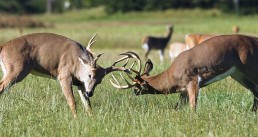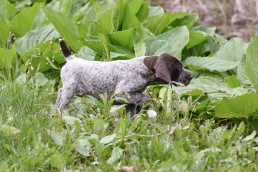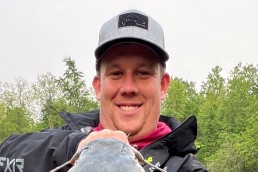A Balanced Herd Means a Concentrated Rut and Happy Whitetails
SHARE THIS POST
All of us who follow sound QDM principals know that you want a balanced sex ratio and a balanced age structure for your herd. But few really understand all the reasons why. Most realize when you have a balanced sex ratio there’s more competition among bucks and that normally means better hunting and better genetics passed along. But if you don’t have this balance, you’ve been missing out on intense rut activity.
Besides the competition and creating an environment where better genetic traits are passed along, stability offers other big benefits to your herd, ones many managers may not realize.
How many does can a buck breed before becoming seriously depleted? For whitetails, especially in the North, it turns from “breeding” time straight into winter over a period of a couple weeks. They never have a chance to recoup the fat and energy lost during the rut.
According to Shorty Flees, of Wilderness Whitetails in Wisconsin, a whitetail buck can breed about seven does (in the wild) before becoming severely depleted. Shorty and his family grow some of the world’s largest bucks and have paid very close attention to this issue over the years. And for good reason—you obviously want to have the genetics of a giant buck passed along, but you don’t want to stress the buck so his antler growth suffers.
At Wilderness Whitetails, they will limit a “breeder buck” to procreate with about 10 does (and this is not in the wild).
“If a buck breeds too many does and becomes rundown, in turn, it hurts his antler growth the following year,” Flees says. “A younger buck can generally handle breeding about six does before running himself down too much. In the North, where winter sets in by the time breeding season ends, bucks become very vulnerable. They cannot build their bodies back up after the rut, so they try to maintain until spring. Come spring, Mother Nature diverts nutrients to rebuilding their body first. Until those needs are satisfied, the antlers get robbed of the nutrients needed to grow to their maximum potential. So bucks that come into the spring depleted are playing catch-up rather than reaping the nutritional rewards.”
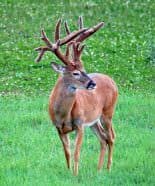
With a balanced herd, the bulk of the breeding takes place over several weeks with a “peak” that lasts about 10 days. With too many does, the breeding may be spread out over many weeks, what some call a “trickle rut.” With a balance, you have an intense rut and the “chase segment” (what most people refer to as the “peak of the rut”)—extreme and concentrated over a few days of some of the best hunting you can imagine.
With an imbalanced ratio, not all the does will be bred during their first estrus cycle. A doe comes into heat for about 36 to 48 hours. If there’s not a buck available to breed her because he’s off tending to other does in the herd, she goes without conceiving. She will come into heat 28 days later, and if she’s not bred by that time she’ll come into heat again 28 days after that. Not only is this extremely bad for the bucks in your herd, think about the poor fawns! Rather than being born in May with the other fawns, he is born in June or even July. Do you think he’ll survive? If he does, he’ll always be inferior to the others.
When the does severely outnumber the bucks, a greater number of young bucks will do some breeding. In this case it’s possible that inferior genetics are passed on, but this is also bad for these young bucks. Normally with older, breeding-age bucks around, through months of social interaction, the younger bucks know their place and don’t attempt to breed, or at least are much less involved. Without older bucks around, the younger bucks will lose body weight and have a high likelihood of being injured. That imbalance is bad for all deer.
Are you enjoying this post?
You can be among the first to get the latest info on where to go, what to use and how to use it!
Why don’t those silly bucks stop by the plot for a quick bite? For some reason bucks just stop eating for a period of a couple weeks surrounding breeding. They don’t “completely” stop, but food intake with bucks in captive herds has shown to drop approximately 90 percent during that period. So even if they have plenty of available food it really doesn’t make any difference during this period—their intense need to breed is so extreme that it consumes their life. Luckily, the does searching for food should be in your plots, so these are still great places to hunt.
There are other reasons to balance your sex ratio. With a shorter rut, more does conceive over a shorter period, which means fawns are dropped within a shorter timeframe as well. This means much higher fawn recruitment. The influx of new fawns means predators are overwhelmed with the amount of prey and fewer fawns are caught. When the rut is drawn out, fawns are born over a longer stretch and predators have a chance to hone in on more newborns.
Achieving the balance can be difficult; it can take several hunting seasons to harvest enough does to make a dent and we may have to battle natural whitetail dispersal, state regulations that “handcuff” our efforts or uneducated neighbors.
Dispersal in the whitetail world typically has buck yearlings searching out a home range a fair distance away from where they were born. Some view this as Mother Nature’s way of preventing inbreeding in the herd. But the doe yearling usually takes up a home range right next to and intertwined with her mother. So if you remove a doe there’s a 50-50 chance that spot will be replaced by another doe. Aggressive action may be required.
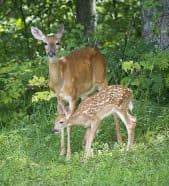
Some states and provinces make it difficult because of their regulations. Some agencies in both the U.S. and Canada are still managing their deer herds like it’s the 1970s. You can purchase one buck tag—that’s it. For example, in my home state of Minnesota, throughout much of the state it’s impossible to manage your herd properly because of a limited amount of antlerless tags. How is it possible to balance your herd in this situation without 20 relatives needing a freezer full of deer meat?
Over the past two years, hunters in Minnesota have been complaining of not seeing many deer, so the DNR lowers antlerless permits further! I say to these hunters: “Try managing your hunting area properly!” I have seen the opposite on the properties that I oversee. I don’t mean to sound condescending, but QDM principals work.
I’m sure there are other great states, but from my experience Missouri has an excellent program: it is inexpensive, or in some cases there are free harvest tags and there are food-shelf programs to deal with the abundance of harvested does. They make it easy to control numbers and give hunters a chance to help the community by bolstering food shelves.
In other cases you have neighbors that are difficult to deal with, or in some cases, even stupid. With neighbors who aren’t “on the same page,” even if you harvest lots of does it seems more just “pour over the fences” to fill the vacated spots. It is becoming easier to convince people of QDM, but you still have some uneducated hunters (typically older hunters) that have the “never-kill-a-doe” mentality. Back in the ‘70s with populations very low, letting the does live was the right call, but in most areas it’s not the right call anymore.
But you can make a difference. “Stick to your guns!” If you have a sound plan things will rebound. It may take several years of aggressive doe removal, but it can be done. I’ve seen it accomplished in many states, countless times. And you will not believe the difference in hunting, especially during the rut. Mature bucks are up on their feet during the rut and the chase is intense. Your herd will also be much better off.
MWO
SHARE THIS POST
Did you enjoy this post?
You can be among the first to get the latest info on where to go, what to use and how to use it!
Todd Amenrud
Todd Amenrud is a full time sportsman whose passion is bowhunting whitetails. He spends considerable time researching whitetails, and has written six books on the subject. Harvesting 47 record-book animals and his ability to share his knowledge have made him one of the Midwest’s most-recognized hunting resources.
